The Amy Winehouse Foundation is helping young women overcome their addictions by bridging the divide between rehab and re-entering society

Amy passed away in 2011
Amy Winehouse’s stunningly unique vocals and soulful songs are her unforgettable legacy, but her tragic death at the age of just 27 is, unfortunately, an unalterable part of her story that also remains in our minds. Her death by alcohol poisoning, after years of substance abuse and several stints in rehab, is a stark reminder of the issues facing vulnerable young women.
But Amy’s family didn’t want her heart-breaking death to be the end of her story. They’ve seen where support can be improved following treatment, and are bridging the gap between rehab and re-entering society in order to help women stay clean and sober, and survive on their own. In 2016, Amy’s Place, a women-only recovery house in London, was born. This means Amy’s legacy can live on, saving other young women from the same tragic fate.
What is Amy's Place?
For young women experiencing addictions, seeking support can be one thing, but there are so many other factors that make adjusting to the wider world very difficult. Leaving rehab can mean going back to accommodation where your neighbour was your drug dealer, or you don’t have a job lined up and so find yourself falling back into old habits without the support to stay clean.
The best thing about Amy’s Place? The girls have each other
Amy’s Place is a facility to change all of that. Young women aged between 18 and 30, who have completed a rehabilitation programme and have three months of sobriety under their belts, are eligible to come to Amy’s Place, which features eight single-occupancy flats and a further four shared-occupancy flats. Women here have the support of keyworkers and staff to help them transition back into society, as well as access to relevant training so they can progress in their careers.
The best thing about Amy’s Place? The girls have each other. Rather than facing the harsh world alone, and returning to toxic environments that initially perpetuated addictions, these women are surrounded by others who have gone through similar experiences. They understand the difficulties each other are facing, support each other moving forwards, and inspire one another with their recovery.
Chantelle's Story

Chantelle has been a resident for over 9 months. Photography | Jesper Mattias
"When I was around six years old, there was a lot of sexual abuse in my family. That went on for a couple of years, with the police involved and ongoing interviews. My mum was an alcoholic, and family weren't supportive. It was dysfunctional and we were neglected.
When I turned 10, I moved into my dad's care. I'd never been shown love, so it was hard for me to accept it, and to know what love was. I didn't know how to react. I rebelled and my anger got the best of me. My dad couldn't control my behaviour, and because I would answer back, he would hit me. I ended up moving into care, then foster care, and then back to my dad's. That was about the time my drinking started to progress.
When I was 16, I moved back to my mum's home, and nothing had changed. She was still the same, the lads in the family were all selling drugs and getting off their face. Mum wasn't feeding me. She couldn't look after herself, so she couldn't look after me.
When I was 17, I got moved into a homeless shelter, and the people there got me involved with the charity Addaction. They were helping me, and eventually I went into treatment. I'd come out of an abusive relationship, and then was in another unhealthy relationship where I was getting off my face with someone all the time. That was the danger point where I knew I had to do something to change it.
I'm now one year sober, and feel I've changed a lot since I walked into Amy's Place
Addaction and my support worker suggested rehab, and told me about Amy's Place. It felt good to know there was Amy's Place for me after treatment. Going into a treatment centre for nearly six months, and seeing your life change from there, it's the unexpected, the unknown, and it's amazing how much I progressed.
I'm now one year sober, and feel I've changed a lot since I walked into Amy's Place. Before, I was angry all the time. I didn't want to connect with others. I was stubborn and blunt, but it was more to do with trusting people and letting them in.
I've been here nine months now. I believe if I keep thinking positively, good stuff is coming.
I recently enrolled in a Level 3 beauty course at college. I've got another year with support at Amy's place, and the course is also a year, so by the time I leave I'll be able to travel and work on cruise ships. I'll be another year clean and sober, and with two years of sobriety, I'll be strong enough to keep going."
Catherine's Journey
Photography | Jesper Mattias
"I started drinking when I was 13. I always drank more than everyone else, and used to get really sick. When I was 16, one of my friends said: "You should take drugs because you can dance all night and they don't make you sick." I took MD for the first time and was like: "This is wonderful." When I was 17, I started taking cocaine.
I grew up quite quickly, because I was like the third parent in my house. The only way I was out and doing something considered a "teenage thing to do" was when I was doing drugs.
My parents are the kind of people that want everything to be fine. They noticed about the drink and drugs a long time ago, but were scared to open up the conversation until it got quite bad. Then I moved out four years ago when I went to dance college, so I was away from them a lot.
Around January this year, I became physically unwell because of it all - in and out of hospital. My friends and family were upset, saying: "You need help." I thought is wasn't affecting anybody else because it was my thing. But then I realised it wasn't just about me.
One of my dance teachers was in recovery herself and took me to my first meeting. I kept going so I could say to people: "I'm going, I'm getting better." It wasn't until the end of April that I actually got clean.
Other people recovering at the same time as you – I can't explain how helpful that is
I don't remember the exact moment I realised I wanted to keep going, but I think it was because of the other people in the group. They'd all worked hard at getting clean, and were genuinely happy facing life without drugs and alcohol. The one thing I did know the whole time was that I was really, really miserable. I was never under some illusion that I was happy. When I saw those people, I thought: "How is this possible?" Other people doing the same thing as you - I can't explain how helpful that is.
I love it here. I lived in a flat before with people who were still using and I didn't really know, so I was completely on my own. But now I feel safe and supported.
I'm about to start a part-time course at RADA because I wanted to be an actress, so I'm focused on that goal at the moment. I'm not exactly sure how I'm going to get there yet. You just have to think if others can do it, so can you."
How does Amy's Place support women aiming to get back into society?
Hannah Chrystal at Amy's Place. Photography | Jesper Mattias

When Happiful visited Amy’s Place, Hannah Chrystal, project manager, told us about the facility, its mission and how her team supports the girls.
“Our aim at Amy’s Place is to help develop these young women’s skills to live independently. Our residents have a tenancy as if they’re in the outside world, but we have the support package downstairs as well. We’ve got two keyworkers that work with them on things like setting up a direct debit, getting energy suppliers, budgeting. We do healthy eating communal meals, where the girls are responsible for cooking and passing on their skills to other members of the house,” said Hannah.
“We engage them in a programme where we have relapse prevention sessions, counselling, Yoga, Reiki, all to keep them busy and involve them in outside activities,” she said. “The aim is to move towards them engaging more with outside the service than within it.”
“This service feels like a community, rather than a supported accommodation service. The girls get on really well and they’re really supportive of each other,” Hannah says. “The relationship the staff have with them is like we’re a part of that community as well; it’s not like ‘us’ and ‘them’.”
What happens when the women are ready to leave?
Amy’s Place can house and support women for up to two years, and the staff work with them individually to look at moving-on options after six months, such as applying for housing with the council. Hannah says: “Some girls have made such a transformation in a year, and are probably ready to move on now. Then there are others who need more support because they’ve never lived alone before.”
"This service feels like a community, rather than a supported accommodation service"
Having positive goals to work towards is a huge part of the transition, motivating the girls with a vision for their life after they leave Amy’s Place, and the steps they need to take to get there.
Does it have success stories
Hannah says most of the girls are success stories. “Chantelle is a real success in terms of engaging in the community,” she says. “She came from a background where there was a lot of trauma and chaos. She didn’t trust people, especially women. When she arrived, she had a very closed attitude, and the other girls found her quite rude. We actually ran a mediation session, and challenged her and the other girls to look at things from each other’s perspectives. Chantelle’s attitude completely changed.”
“Another lady came here with no custody of her children, and couldn’t even have visitation with them,” Hannah says. “Now, she’s very close to getting full custody of them.”

Can Amy's Place make a difference?
In 2011, public attitudes towards mental illness looked a lot different. In the past year, strides have been made in spreading awareness, breaking down stigma, and educating ourselves as to what mental health is, and the reasons behind people’s difficulties.
It makes you wonder whether, if people had been more compassionate to addiction and mental illness at the time, maybe Amy could have been saved?
Initiatives such as Amy’s Place are saving lives. They’re supporting vulnerable young women on the road to recovery, and turning their lives around. If we had more safe, supportive spaces in our society, who knows how much brighter the future of our society could become?
To find out more about Amy’s Place, visit the Amy Winehouse Foundation's website. You can also read Happiful's interview with Mitch Winehouse, Amy's father and founder of the Amy Winehouse Foundation.
Image of Amy | Robin Atzeni / shutterstock.com




Comments